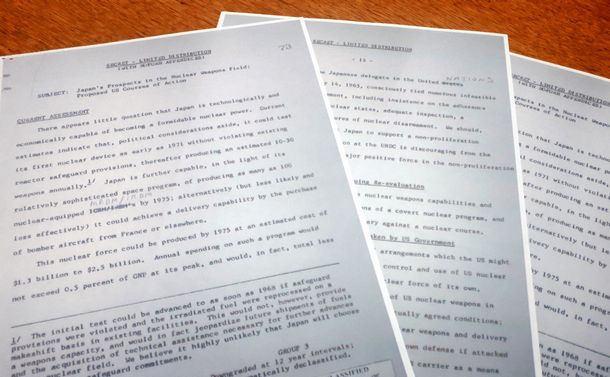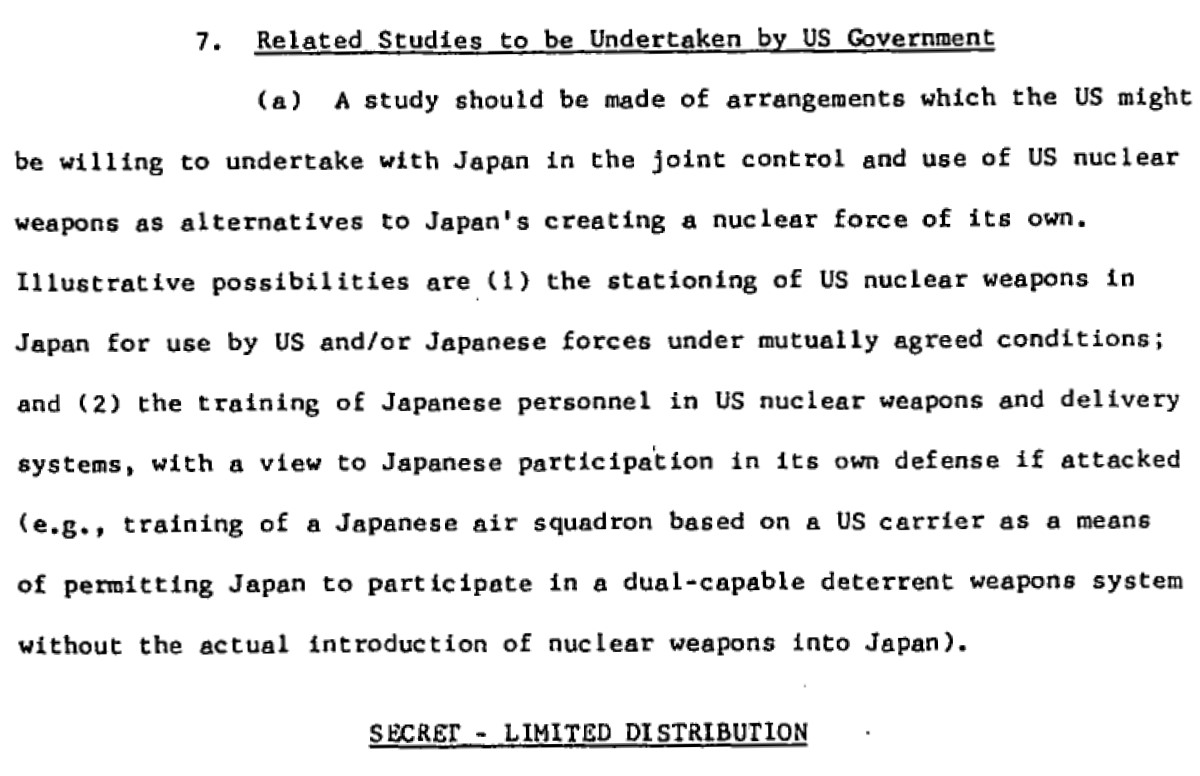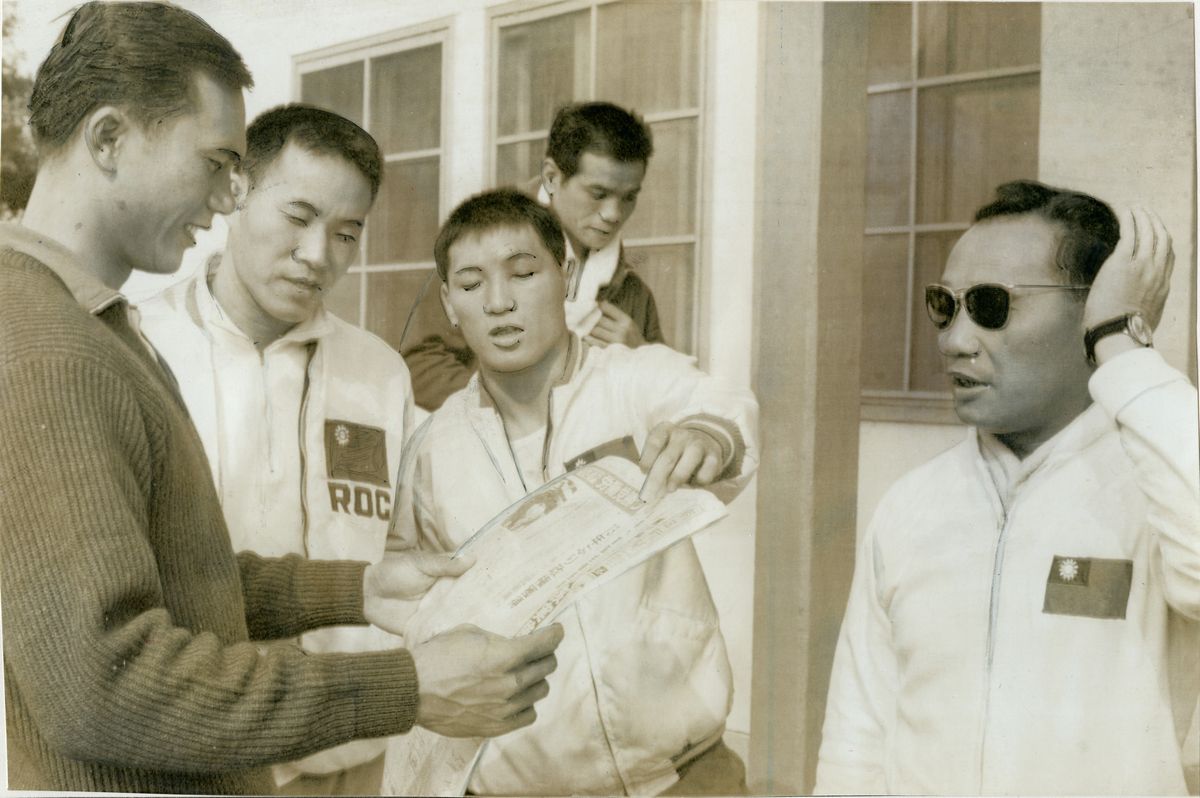Our Advertisers Represent Some Of The Most Unique Products & Services On Earth!

Is Japan's Elite Hiding A Weapons
Program Inside Nuclear Plants?
By Yoichi Shimatsu
This article first appeared at New America MediaNews Analysis, Yoichi Shimatsu, Posted 4-6-11 c. 2011 Yoichi Shimatsu - All Rights Reserved
4-6-11- Confused and often conflicting reports out of Fukushima 1 nuclear plant cannot be solely the result of tsunami-caused breakdowns, bungling or miscommunication. Inexplicable delays and half-baked explanations from Tokyo Electric Power Company (TEPCO) and the Ministry of Economy, Trade and Industry (METI) seem to be driven by some unspoken factor.
- The smoke and mirrors at Fukushima 1 seem to obscure a steady purpose, an iron will and a grim task unknown to outsiders. The most logical explanation: The nuclear industry and government agencies are scrambling to prevent the discovery of atomic-bomb research facilities hidden inside Japan's civilian nuclear power plants.
- A secret nuclear weapons program is a ghost in the machine, detectable only when the system of information control momentarily lapses or breaks down. A close look must be taken at the gap between the official account and unexpected events.
- Conflicting Reports
- TEPCO, Japan's nuclear power operator, initially reported three reactors were operating at the time of the March 11 Tohoku earthquake and tsunami. Then a hydrogen explosion ripped Unit 3, run on plutonium-uranium mixed oxide (or MOX). Unit 6 immediately disappeared from the list of operational reactors, as highly lethal particles of plutonium billowed out of Unit 3. Plutonium is the stuff of smaller, more easily delivered warheads.
- A fire ignited inside the damaged housing of the Unit 4 reactor, reportedly due to overheating of spent uranium fuel rods in a dry cooling pool. But the size of the fire indicates that this reactor was running hot for some purpose other than electricity generation. Its omission from the list of electricity-generating operations raises the question of whether Unit 4 was being used to enrich uranium, the first step of the process leading to extraction of weapons-grade fissionable material.
- The bloom of irradiated seawater across the Pacific comprises another piece of the puzzle, because its underground source is untraceable (or, perhaps, unmentionable). The flooded labyrinth of pipes, where the bodies of two missing nuclear workers-never before disclosed to the press- were found, could well contain the answer to the mystery: a lab that none dare name.
- Political Warfare
- In reaction to Prime Minister Naoto Kan's demand for prompt reporting of problems, the pro-nuclear lobby has closed ranks, fencing off and freezing out the prime minister's office from vital information. A grand alliance of nuclear proponents now includes TEPCO, plant designer General Electric, METI, the former ruling Liberal Democratic Party and, by all signs, the White House.
- Cabinet ministers in charge of communication and national emergencies recently lambasted METI head Banri Kaeda for acting as both nuclear promoter and regulator in charge of the now-muzzled Nuclear and Industrial Safety Commission. TEPCO struck back quickly, blaming the prime minister's helicopter fly-over for delaying venting of volatile gases and thereby causing a blast at Reactor 2. For "health reasons," TEPCO 's president retreated to a hospital ward, cutting Kan's line of communication with the company and undermining his site visit to Fukushima 1.
- Kan is furthered hampered by his feud with Democratic Party rival Ichiro Ozawa, the only potential ally with the clout to challenge the formidable pro-nuclear coalition
- The head of the Liberal Democrats, which sponsored nuclear power under its nearly 54-year tenure, has just held confidential talks with U.S. Ambassador John Roos, while President Barack Obama was making statements in support of new nuclear plants across the U.S.
- Cut Off From Communications
- The substance of undisclosed talks between Tokyo and Washington can be surmised from disruptions to my recent phone calls to a Japanese journalist colleague. While inside the radioactive hot zone, his roaming number was disconnected, along with the mobiles of nuclear workers at Fukushima 1 who are denied phone access to the outside world. The service suspension is not due to design flaws. When helping to prepare the Tohoku crisis response plan in 1996, my effort was directed at ensuring that mobile base stations have back-up power with fast recharge.
- A subsequent phone call when my colleague returned to Tokyo went dead when I mentioned "GE." That incident occurred on the day that GE's CEO Jeff Immelt landed in Tokyo with a pledge to rebuild the Fukushima 1 nuclear plant. Such apparent eavesdropping is only possible if national phone carrier NTT is cooperating with the signals-intercepts program of the U.S. National Security Agency (NSA).
- The Manchurian Deal
- The chain of events behind this vast fabrication goes back many decades.
- During the Japanese militarist occupation of northeast China in the 1930s, the puppet state of Manchukuo was carved out as a fully modern economic powerhouse to support overpopulated Japan and its military machine. A high-ranking economic planner named Nobusuke Kishi worked closely with then commander of the occupying Kanto division, known to the Chinese as the Kwantung Army, General Hideki Tojo.
- Close ties between the military and colonial economists led to stunning technological achievements, including the prototype of a bullet train (or Shinkansen) and inception of Japan's atomic bomb project in northern Korea. When Tojo became Japan's wartime prime minister, Kishi served as his minister of commerce and economy, planning for total war on a global scale.
- After Japan's defeat in 1945, both Tojo and Kishi were found guilty as Class-A war criminals, but Kishi evaded the gallows for reasons unknown-probably his usefulness to a war-ravaged nation. The scrawny economist's conception of a centrally managed economy provided the blueprint for MITI (Ministry of International Trade and Industry), the predecessor of METI, which created the economic miracle that transformed postwar Japan into an economic superpower.
- After clawing his way into the good graces of Cold Warrior John Foster Dulles, Eisenhower's secretary of state, Kishi was elected prime minister in 1957. His protégé Yasuhiro Nakasone, the former naval officer and future prime minister, spearheaded Japan's campaign to become a nuclear power under the cover of the Atomic Energy Basic Law.
- American Complicity
- Kishi secretly negotiated a deal with the White House to permit the U.S. military to store atomic bombs in Okinawa and Atsugi naval air station outside Tokyo. (Marine corporal Lee Harvey Oswald served as a guard inside Atsugi's underground warhead armory.) In exchange, the U.S. gave the nod for Japan to pursue a "civilian" nuclear program.
- Secret diplomacy was required due to the overwhelming sentiment of the Japanese public against nuclear power in the wake of the Hiroshima and Nagasaki atomic bombings. Two years ago, a text of the secret agreement was unearthed by Katsuya Okada, foreign minister in the cabinet of the first Democratic Party prime minister, Yukio Hatoyama (who served for nine months from 2009-10).
- Many key details were missing from this document, which had been locked inside the Foreign Ministry archives. Retired veteran diplomat Kazuhiko Togo disclosed that the more sensitive matters were contained in brief side letters, some of which were kept in a mansion frequented by Kishi's half-brother, the late Prime Minister Eisaku Sato (who served from 1964-72). Those most important diplomatic notes, Togo added, were removed and subsequently disappeared.
- These revelations were considered a major issue in Japan, yet were largely ignored by the Western media. With the Fukushima nuclear plant going up in smoke, the world is now paying the price of that journalistic neglect.
- On his 1959 visit to Britain, Kishi was flown by military helicopter to the Bradwell nuclear plant in Essex. The following year, the first draft of the U.S.-Japan security was signed, despite massive peace protests in Tokyo. Within a couple of years, the British firm GEC built Japan's first nuclear reactor at Tokaimura, Ibaragi Prefecture. At the same time, just after the 1964 Tokyo Olympics, the newly unveiled Shinkansen train gliding past Mount Fuji provided the perfect rationale for nuclear-sourced electricity.
- Kishi uttered the famous statement that "nuclear weapons are not expressly prohibited" under the postwar Constitution's Article 9 prohibiting war-making powers. His words were repeated two years ago by his grandson, then Prime Minister Shinzo Abe. The ongoing North Korea "crisis" served as a pretext for this third-generation progeny of the political elite to float the idea of a nuclear-armed Japan. Many Japanese journalists and intelligence experts assume the secret program has sufficiently advanced for rapid assembly of a warhead arsenal and that underground tests at sub-critical levels have been conducted with small plutonium pellets.
- Sabotaging Alternative Energy
- The cynical attitude of the nuclear lobby extends far into the future, strangling at birth the Japanese archipelago's only viable source of alternative energy-offshore wind power. Despite decades of research, Japan has only 5 percent of the wind energy production of China, an economy (for the moment, anyway) of comparable size. Mitsubishi Heavy Industries, a nuclear-power partner of Westinghouse, manufactures wind turbines but only for the export market.
- The Siberian high-pressure zone ensures a strong and steady wind flow over northern Japan, but the region's utility companies have not taken advantage of this natural energy resource. The reason is that TEPCO, based in Tokyo and controlling the largest energy market, acts much as a shogun over the nine regional power companies and the national grid. Its deep pockets influence high bureaucrats, publishers and politicians like Tokyo Governor Shintaro Ishihara, while nuclear ambitions keep the defense contractors and generals on its side. Yet TEPCO is not quite the top dog. Its senior partner in this mega-enterprise is Kishi's brainchild, METI.
- The national test site for offshore wind is unfortunately not located in windswept Hokkaido or Niigata, but farther to the southeast, in Chiba Prefecture. Findings from these tests to decide the fate of wind energy won't be released until 2015. The sponsor of that slow-moving trial project is TEPCO.
- Death of Deterrence
- Meanwhile in 2009, the International Atomic Energy Agency (IAEA) issued a muted warning on Japan's heightened drive for a nuclear bomb- and promptly did nothing. The White House has to turn a blind eye to the radiation streaming through American skies or risk exposure of a blatant double standard on nuclear proliferation by an ally. Besides, Washington's quiet approval for a Japanese bomb doesn't quite sit well with the memory of either Pearl Harbor or Hiroshima.
- 日本のエリートは核兵器開発を隠しているのか?
日本のエリートが原発の中に隠しているのか?
島津洋一著
この記事はNew America Mediaに掲載されたものです。
ニュース分析、島津洋一、投稿4-6-11
c. 2011 島津洋一 - All Rights Reserved
4-6-11
福島第一原子力発電所の混乱した、しばしば矛盾した報道は、津波による故障、不手際、連絡ミスだけのせいにはできない。東京電力や経済産業省の不可解な遅れや中途半端な説明には、何らかの暗黙の了解があるように思われる。
福島第一原発の煙と鏡は、着実な目的、鉄の意志、そして外部に知られていない厳しい仕事を見えにくくしているようだ。最も論理的な説明である。原子力産業と政府機関は、日本の民間原子力発電所内に隠された原爆研究施設の発見を阻止するために躍起になっている。
核兵器開発は、情報管理体制が一瞬崩れたり、壊れたりしたときに発見される「機械の中の幽霊」である。公式発表と予想外の出来事の間にあるギャップに目を向けなければならない。
矛盾する報告
東京電力は当初、3月11日の東日本大震災発生時に3基の原子炉が稼働していたと発表した。その後、プルトニウム・ウラン混合酸化物(MOX)で運転されていた3号機が水素爆発で破壊された。3号機からは致死性の高いプルトニウムが噴出し、6号機は直ちに稼働中の原子炉から姿を消した。プルトニウムは、より小型で運搬しやすい核弾頭の材料となる。
号機は、使用済みウラン燃料棒が乾燥した冷却プールの中で過熱したため、破損した筐体内で発火したという。しかし、火災の規模から見て、この原子炉は発電以外の目的で高温になっていたことが分かる。4号機は、兵器用核分裂性物質を取り出すためのウラン濃縮に使われていたのだろうか。
太平洋を横断する照射された海水の洪水は、パズルのもう一つのピースである。なぜなら、その地下水源が追跡できない(というより、言及できない)からである。この謎を解くのは、誰も名前を挙げることができない研究所である。
政治的な戦い
菅直人首相が問題点の迅速な報告を求めたことに反発し、原発推進派は、首相官邸に重要な情報を入れないように封鎖し、凍結している。東電、GE、経産省、旧自民党、そしてどう見てもホワイトハウスを含む原発推進派の大連合。
最近、通信と国家非常事態を担当する閣僚は、経済産業省の海江田万里代表が原子力推進者と規制当局である原子力安全委員会を兼任していることを非難した。東京電力はすぐに反撃に転じ、首相のヘリ飛行が揮発性ガスの排出を遅らせ、その結果2号機の爆発を招いたと非難した。東電社長は「健康上の理由」で病棟に引きこもり、菅首相と東電の連絡は途絶え、福島第1原発の視察もままならなくなった。
菅首相は、民主党のライバルである小沢一郎氏との確執によって、さらに足かせをかけられている。
約54年間の在任期間中、原発を後援してきた自民党のトップは、ジョン・ルース米国大使と極秘会談を行ったばかりで、その間にバラク・オバマ大統領が全米で新しい原発を支持する発言をしていた。
通信手段を断つ
東京とワシントンの非公開の会談の内容は、私が最近行った日本人ジャーナリストの同僚との電話のやり取りが中断されたことから推測することができる。放射能汚染地域内にいるとき、彼の携帯電話番号が切断されたのだ。このサービス停止は、設計上の欠陥によるものではない。私は、1996年の東北地方太平洋沖地震対策本部で、携帯電話基地局のバックアップ電源と高速充電の確保に悪戦苦闘した。
その後、同僚が東京に帰ってきたときにかけた電話で、「GE」と言ったら切れてしまった。その日は、GEのジェフ・イメルトCEOが福島第一原発の再建を掲げて東京に降り立った日だった。このような明らかな盗聴は、国営電話会社NTTが米国家安全保障局(NSA)の信号傍受プログラムに協力している場合にのみ可能である。
満州族の取引
この巨大な捏造の背後にある出来事の連鎖は、何十年も前にさかのぼる。
1930年代の日本軍国主義による中国東北部の占領中、満州国という傀儡国家は、人口過密の日本とその軍事機構を支えるための完全な近代的経済大国として切り開かれた。岸信介という高位の経済計画家が、当時の関東軍司令官であった東条英機と緊密に連携していた。
新幹線の原型や朝鮮半島北部での原爆計画など、軍部と植民地経済学者との緊密な連携は、驚くべき技術的成果をもたらした。東条が戦時中の首相になると、岸は商工大臣として世界規模の総力戦を計画した。
敗戦後、東条も岸もA級戦犯として有罪になったが、岸は絞首台から逃れ、おそらく戦争で荒廃した日本にとって有益な存在であったのだろう。このやせっぽちの経済学者が考えた中央管理型経済は、通産省(現経済産業省)の青写真となり、戦後の日本を経済大国へと変貌させる「経済の奇跡」を起こした。
岸は、アイゼンハワーの国務長官であった冷戦戦士ジョン・フォスター・ダレスに気に入られ、1957年に首相に就任した。岸は、1957年に首相に就任した。岸に仕えた海軍士官の中曽根康弘は、後に首相となり、原子力基本法に基づく核保有国への移行を主導する。
アメリカも加担
岸首相は、米軍が沖縄と厚木飛行場に原爆を貯蔵することを認めるようホワイトハウスと密かに交渉していた。(リー・ハーヴェイ・オズワルド海兵隊員は厚木の地下核弾頭兵器庫の警備員として勤務していた)。その見返りに、アメリカは日本の「民生用」核開発計画を許可した。
広島・長崎の原爆投下後、日本国民の圧倒的な反原発感情から、秘密外交が必要とされたのである。年前、民主党の初代首相、鳩山由紀夫内閣の外相だった岡田克也氏(2009年から10年までの9カ月間在任)によって密約の文面が明らかにされた。
外務省の公文書館に保管されていたこの文書には、多くの重要な内容が欠けていた。元外交官の東郷和彦氏は、より機密性の高い事柄は、岸氏の異母兄である故佐藤栄作首相(1964~72年在任)が頻繁に訪れた邸宅に保管されていた短い側文書に書かれていたと明かした。その最も重要な外交文書が持ち出され、その後行方不明になったと東郷は付け加えた。
これらの事実は、日本では大きな問題となったが、欧米のメディアではほとんど無視された。福島原発の事故は、そのツケを払うことになった。
1959年、岸は英国を訪問した際、軍のヘリコプターでエセックス州のブラッドウェル原発を視察している。翌年、東京での大規模な平和運動にもかかわらず、日米安保の第一次草案が調印された。それから2、3年のうちに、イギリスのGEC社が日本初の原子炉を茨城県東海村に建設した。また、1964年の東京オリンピックの直後、富士山を滑走する新幹線は、原子力発電に最適な理由付けとなった。
岸は、戦後憲法9条の戦力外通告で「核兵器は明文で禁止されていない」という有名な言葉を発した。この言葉は孫の安倍晋三首相(当時)が繰り返した。現在進行中の北朝鮮「危機」は、この政治エリートの3代目の子孫が日本の核武装構想を浮上させる口実となった。多くの日本のジャーナリストや情報専門家は、秘密計画は核弾頭の迅速な組み立てのために十分に進歩し、小さなプルトニウムペレットを使った臨界前レベルの地下実験が行われたと考えている。
代替エネルギーへの妨害工作
原子力ロビーの冷笑的な態度は、日本列島で唯一の代替エネルギー源である洋上風力発電を生まれながらにして窒息させ、はるか未来にまで及んでいる。数十年にわたる研究にもかかわらず、日本の風力発電の生産量は、同程度の経済規模を持つ中国のわずか5%である(今のところ、とにかく)。ウェスチングハウス社の原子力パートナーである三菱重工業は、風力タービンを製造しているが、輸出市場向けのみである。
シベリア高気圧の影響で北日本には安定した強い風が吹いているが、電力会社はこの天然資源を利用していない。東京に本社を置き、最大のエネルギー市場を支配する東京電力が、9つの地域電力会社や全国送電網を支配する将軍のような存在だからである。東京電力の私腹は、官僚や出版社、石原慎太郎東京都知事のような政治家に影響を与え、核開発への野心は、防衛関連企業や将軍を味方につけている。しかし、東京電力はトップ・ドッグではない。この巨大事業におけるシニアパートナーは、岸のブレーンである経済産業省である。
洋上風力発電の国営試験場は、残念ながら風の強い北海道や新潟ではなく、さらに南東にある千葉県にある。風力発電の運命を決めるこの試験の結果が出るのは、2015年になってからだ。その遅々として進まない実証実験のスポンサーは東京電力である。
抑止力の死
一方、2009年、国際原子力機関(IAEA)は、日本の核爆弾への意欲が高まっているとして控えめな警告を発したが、すぐに何もしなかった。ホワイトハウスは、米国の空を流れる放射能に目をつぶるか、同盟国による核拡散に対する露骨なダブルスタンダードを暴露するリスクを負わなければならない。その上、日本の原爆を黙認することは、真珠湾攻撃や広島の記憶とうまくかみ合わない。




